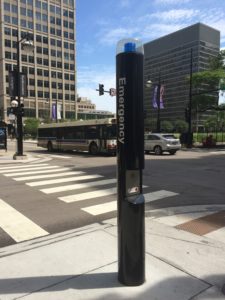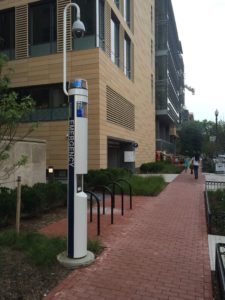This article was originally published in the May 2016 edition of American Security Today.
Download a PDF of this article here.
BY MICHAEL ZUIDEMA
 Security likely will be an eternal challenge for cities and large municipal settings. Mitigate one potentially dangerous situation and a new one seems to pop up in an instant. It’s an uphill progression that seems to have no end in sight.
Security likely will be an eternal challenge for cities and large municipal settings. Mitigate one potentially dangerous situation and a new one seems to pop up in an instant. It’s an uphill progression that seems to have no end in sight.
Regardless, it’s vital to be continually proactive in bolstering the safety of these bustling and vibrant communities. From downtown streets, shopping centers and parks to corporate facilities, stadiums and parking garages, urban environments require a variety of diverse security solutions in order to meet their demanding and ever-changing needs.
With that in mind, many municipal settings have embraced the implementation of sophisticated emergency communication options that are available for anyone to use at any time of day. For example, housing a hands-free speakerphone in a durable enclosure in both indoor and outdoor settings not only offers a high level of durability that will resist vandals, intense weather conditions and other forms of abuse, but provides reliable two-way communication with first responders who can react to a request for assistance in an effective manner.
The benefits do not have to end there. Many enclosures available on the market can easily incorporate additional security equipment, including surveillance cameras, public address systems, housings for Automated External Defibrillator (AED) devices, Areas of Refuge, assembly points and more. They also have the ability to integrate with additional video management and access control software solutions to provide cities with more flexibility by giving them the ability to tie different security systems together, thereby maximizing the return on investment and providing scalability for future expansion and updates.
As a result, emergency communication devices offer another level of security that can reclaim potentially dangerous locations by increasing visibility and serving as a beacon for those in need. This is extremely helpful in large cities where skyscrapers and other structural features create tight spaces and limited sightlines, and facilities can be so massive and sprawling that it’s financially untenable to have a manned security force capable of perpetually blanketing the entire location at all times of day. Physical security devices can serve as the eyes and ears needed to aid assist people in distress and direct security forces to the areas where they are most in need. Plus, since they are installed in fixed locations, they can help first responders more accurately pinpoint the areas where help is requested.
In addition to giving people the ability to swiftly notify authorities in emergency situations, the versatility of physical security devices can be utilized for a number of nonemergency situations, such as a driver requesting help after locking their keys in the car or a tourist asking for directions. A number of emergency speakerphones are equipped with contact closures that can assist with access door and gate communication.
As security personnel continue to play an integral role in visitor satisfaction, authorities are contemplating the advantages tied to having multiple channels of communication for engaging with those at their locations. Simply installing a durable and visible device can go a long way to enhancing the experience from a customer service mindset, not to mention any life-threatening situations that may pose a more dire threat. This way, if you see or need something, there is a discreet way to say something.
 By placing physical security devices in popular and visible locations, cities give their constituents a means to seek help wherever they go, whenever they need it. This gives individuals the peace of mind of a safe environment, which can go a long way toward augmenting a region’s reputation. For example, according to a study published by the International Foundation for Protection Officers, the number one reason people shopped at one place compared to another was safety. If a customer doesn’t feel safe in a store, they typically will leave and shop somewhere else – possibly in another city.
By placing physical security devices in popular and visible locations, cities give their constituents a means to seek help wherever they go, whenever they need it. This gives individuals the peace of mind of a safe environment, which can go a long way toward augmenting a region’s reputation. For example, according to a study published by the International Foundation for Protection Officers, the number one reason people shopped at one place compared to another was safety. If a customer doesn’t feel safe in a store, they typically will leave and shop somewhere else – possibly in another city.
Cities are devoted to protecting everyone that crosses their streets, whether they’re residents or just passing through. Security is an ever-changing landscape, forcing authorities to continually adjust and adapt to new threats and scenarios. The addition of physical security devices is one way for municipal locations to ensure people know that help is always available.
Michael Zuidema is the Marketing Operations Manager for Code Blue Corporation.
